Your product listing copy can make or break your Amazon business. Think about it – small conversion oriented optimizations can result in thousands or even hundreds of thousands of dollars in sales over the product’s lifespan that would have otherwise been lost. As such it is critical that your listings are well optimized, which results in better rankings in the search results and thus higher conversions. In this article we are going to take a deep dive into product descriptions, one of the key elements of a strong product listing. By the end of the article, you should have an understanding of how to write an effective product description, and just as important, how NOT to write one. But first, let’s take a look at what makes a great product description.
What Makes An Effective Product Description?
If one of the primary goals of your Amazon listing copy, including your description, is to rank well in the search results, we must first consider how Amazon ranks products in the first place. Amazon uses a computer algorithm called A9 to determine where to place products in the search results.
One of the key ways the A9 algorithm works is by looking at the keywords used in your listing to understand what your product is. As such, one critical component to a strong description is to include relevant keywords. The aim is to teach the Amazon algorithm about your product. Equally important is to exclude irrelevant keywords so that you are not indexed for the wrong terms, i.e. you don’t want to teach A9 the wrong things about your product. Due to its importance, we will discuss the how of keyword research in another post.
A second factor is your sales history. That is to say, there is a very reliable correlation between the products that sell the most and those that rank the highest in the search results. Why does Amazon rank the biggest revenue driving products the highest? Quite simply because it makes them the most money. It’s also the best way to operate as it satisfies the most people. Think about it…by placing the best sellers higher up in the results, Amazon makes the most revenue, the seller makes the most revenue and the largest number of customers are served this way.
So in addition to having the right keywords, your descriptions should also follow fundamental copywriting principles so as to maximize conversions. Conversion focused copy means more sales, which means the algorithm will rank us higher in the search results, which will result in more visibility which will in turn create more sales. Thus, the result is a reciprocating cycle of upward growth. Before we jump into the details of conversion focused copy, let’s first start with the basics.
Why Do People Buy Anything?
People buy simply because they expect some payoff/benefit whether it’s solving a painful problem or for mere pleasure. Think about the last time you bought something. A toilet plunger deals with the painful (and gross) problem of a blockage. That cinnamon roll you bought at the mall, when you were not even hungry, was for the mere pleasure of it…not necessarily to solve a problem.
To craft persuasive copy, we have to focus on both of these factors: the pain points that are being solved and the mere pleasures that the customer might experience – these are the benefits that make people buy. To effectively communicate these benefits, we have to first enter the mind of our ideal customer so that our writing can speak to them. Let’s create a buyer persona to help us with this.
Step 1: Create a Buyer Persona
A buyer persona is simply a semi-fictional portrait of who your ideal customer is. To create your buyer persona, think about a typical customer in your target market and answer the following questions:
- What is his/her background? (Think job, family)
- What are his/her demographics? (Sex, age, income, location)
- What are his/her identifiers? (Demeanor, communication preference)
- What are his/her motives? (Goals, emotions, challenges)
Here are the common motives behind most purchases:
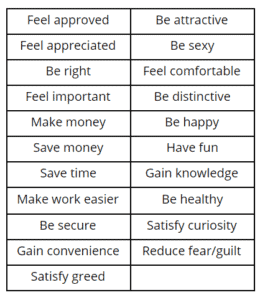
- What are his/her pain points?
It also helps to give your semi-fictional character a name, and to even find a stock image to represent them.
Now that we know what a buyer persona is, let’s create one for a Children’s Behavior Reward Chart.
Name: Let’s call our imaginary customer Proactive Pearl
What is her background? (Think job, family)
Proactive Pearl is an accomplished lawyer who just welcomed her third child. Two is the perfect number, and she has a vision for the three of them. One key element of this vision is that she wants to instill healthy habits from young to set them up for success. After all, this is what her parents pushed her to do, and she now appreciates it.
What are her demographics? (Sex, age, income, location)
Proactive Pearl is in her early thirties and makes a middle class salary. She lives in a relatively affluent area, but of course doesn’t plan on settling there…it’s merely a stepping stone to her dream home – one of the big milestones on her bucket list.
What are their identifiers? (Demeanor, mindset)
Proactive Pearl is very future-focused. She is not only crushing her career goals but is also progressing her personal goals. After all, her mantra is ‘the prize is in the progress’. The mindfulness, ‘living in the now’ school of thought has no place in her life philosophy – maybe later when she has accomplished all of her goals. As for right now, she’s focused, keeps track of her vision, and aims to take steps daily to make those goals a reality.
What are her motives? (Goals, emotions, challenges)
She’s driven by having a balanced life which comprises a successful career, social circle, fitness, and family. Her kids are her life, and everything she does is for them. She feels proud knowing that she is a proactive parent as she invests in their future. She wants to provide everything they need, but at the same time, teach them that you have to work for what you want in life. Another motivating factor that drives her is feeling accomplished and being recognized by others for her achievements. Her biggest challenge is focus. There’s so much that she wants to get done, that she does not have enough time and energy for it all, which is why she has a goal diary where she schedules her priorities only.
What are her pain points?
Her biggest fear is her children not making the most of the potential she knows that they have. She fears that her children pick up bad habits that will be tough to break later -she knows that if she can just help them establish a few key behaviors that they will do well in life, and have successful careers and families too. She knows that her career and life itself is very demanding, and is afraid that she loses focus from the vision that she has for them – she’d feel guilty if this happened.
Step 2: Discover the Benefits of Your Product
Once you have an idea of who you’re selling to and the reasons why they may want to buy, the next step is to connect the features and benefits of your product with their motives. There is an old marketing cliché that says ‘people don’t buy features, they buy benefits’. And that is true. Think about it, the last time you bought a face mask, you were not thinking of the cotton material or elastic strap, but of the complete coverage for your safety, and the comfort, for your sanity.
To help discover the benefits of our product, we are going to use a simple feature-benefit table. Make a list of all the features of your product in one column, no matter how dry, boring or obvious, and in the other, let’s think about why Proactive Pearl might want this, i.e. how each features benefits her. You may want to revisit the list of buyer motives discussed earlier. Pro tip: It can help to think of your product in terms of its most basic structural elements, e.g. a pencil’s hexagonal barrel means it won’t roll off the table; its 6″ length means a long writing life.
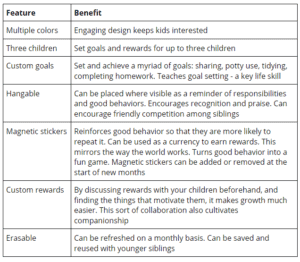
Step 3: Write the First Draft
Now that we’ve done all of the prep work, we can actually start writing. But where do we begin? And what goes in the middle and end? Fortunately, there are tried and tested copywriting formulas that answer exactly these questions. We like the AIDA formula:
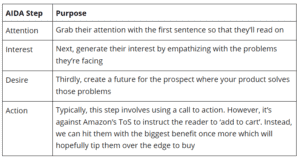
Here’s Our Description Written Using AIDA
Red-Attention
Green-Interest
Black-Desire
Blue-Call to Action
This overlooked strategy has been used by psychologists for the last 30 years to shape children’s behavior. Whether you want to stop certain behaviors, like tantrums, or start others, like tidying, sharing or even potty use, this strategy can help. What is this strategy you ask? Reward Charts! [Brand] Reward Chart is built upon the same powerful psychological principles used by the experts, and helps you effortlessly increase desirable behaviors in your children, and decrease undesirable ones.<br><br>With custom goal and reward areas, you can set your own goals and use the rewards that really motivate your children. Stickers make it easy to recognize and reinforce good behavior, and motivates children to repeat those behaviors again and again. Its hangable design means you can place it just about anywhere to remind you and your child of desired goals and the rewards they will earn for successful completion. [Brand] chart also serves a reminder of the small successes along the journey that lead to the big outcome. Made for up to 3 children, it also encourages friendly competition and collaboration, and turns their goals into a fun game. Its multicolor design is engaging, perfect for children of ages 5 to 10.<br><br>But isn’t this manipulative, you might be wondering, like training a dog? No! Our reward chart is a team effort and requires collaboration between parents and children. It not only cultivates a sense of companionship, but allows you to instill key goal setting habits that set up your child for future success. Featuring magnetic stickers and an erasable surface, you can rework the board at the start of every month, or make adjustments as goals change. It can even be saved and used with younger, upcoming siblings, so you’ll be using it for years to come – and when they are all grown up, it can be given to a friend as a gift. So if you’re struggling with your children’s behavior, go [Brand] and stop groaning, and start growing together today!
Step 4: Edit Your First Draft Using These Pro Tips:
Don’t Hard Sell
People love to buy, but no one likes to be sold. Think of the last time an insurance agent tried to sell you a policy. The moment you realized the intent of the conversation, your guard probably went up. This is a well documented phenomenon in Psychology called persuasion resistance. We tend to resist being persuaded or sold against our initial inclination, probably because we assume that it’s good for them, not us. The take away point is to avoid overly salesy language. It is likely that your prospects already know what they are looking for and are just trying to check their mental boxes – if your product fits the profile they’re looking for, they’ll buy. Don’t create unnecessary resistance.
Write for Humans, not Search Engines
One common mistake people make is over optimizing their listing by stuffing it with keywords. This results in copy that’s difficult to read as it usually does not flow well. If customers are turned off from reading, they are less likely to buy. So counterintuitively, this is a situation where less can mean more.
Instead of overstuffing, aim for a balance. A helpful way to think of it is that you should write your copy for humans, and seamlessly incorporate keywords for the A9 algorithm.
Keywords only need to be added once for it to be indexed. For example, if you are selling silk hair bonnets, you do not need to have the phrases ‘silk hair bonnet’ and silk ‘silk hair bonnet for women’ just because they are two highly searched phrases. After silk hair bonnet is used in the copy, once you include the word women somewhere else and A9 will pick up on it.
Short Sells
Every line in your description should have a purpose. This is a very useful way to think of, and analyze your entire listing. Think about it…the purpose of your title is to get the customer to click on your listing from the search engine results page, and to read the first bullet. The purpose of your first bullet is for them to read the second, and so on.
The same goes for your description. Every line should lead to the other from start to end with one goal in mind – for them to click the button, i.e. ‘Add to Cart’. Do not expand your copy just for the sake of exhausting the character limits – only add to your copy if it helps the customer get to the button, and do it in as little words as possible. Remember, attention is short, and the more customers have to scroll and read, the more they are exposed to competitor products trying to steal them away from your listing.
Obey Amazon’s Terms of Service
One of the worst things that can happen is to start growing your business only for your listing to get taken down. This can happen if you violate Amazon’s Terms of Service. There are some things that you cannot include in your product description.
Avoid:
- Promotional language such as ‘best selling’ or ‘free shipping’
- Mention of competitor brands
- Reviews or quotes
- Availability information, for example, scarcity sales tactics
- Information about item conditions
Use HTML to Give Your Text Breathing Room
Large walls of text can be a turn off. Apart from keeping your description as short as is possible, another helpful practice is to use HTML to break up the text. Only line breaks (<br>) are officially supported by Amazon, which, if used well, should be all you need.
Example:
Without HTML:
Waspinator – The natural alternative to harmful pesticides. Benefits: Natural, Effective, Environment Safe
Output:

With HTML:
Waspinator – The natural alternative to harmful pesticides.<br><br>Benefits:<br>Natural<br>Effective<br>Environment Safe
Output:
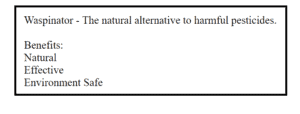
Notice how much more legible the HTML formatted example is to read. You can also get creative and add a few rapid-fire bullet points to reinforce your main selling points. To use line breaks, simply add <br> anywhere you want the text to break to the next line. Add it twice <br><br> if you want to skip a line. Some people use other HTML functions such as bolding. However, Amazon officially allows line breaks only. With Amazon’s ever changing policies and enforcement practices, we suggest that you stick with their ToS.
Negate Negative Reviews
The description, just like the bullets, presents an opportunity to negate common negative reviews. For example, let’s say you’re selling a decoy wasp nest (which keeps away foreign wasps due to their territorial nature), but it tends to lose color when exposed to the elements, and customers have been complaining about this and leaving negative ratings – you can amend your copy to set this expectation upfront. For example, the bullets, or product description can read ‘The [Brand] Decoy Wasp Nest should not be directly exposed to the elements, otherwise, it will lose its original color’. The idea is that customers will have the right expectation upfront and are less likely to be surprised if that does happen, which mitigates the chances of a negative review.
Use simple words
Amazon is used by people of different ages, educational backgrounds and even language proficiencies. A good rule of thumb for all copywriting in general is to use simple, easy to understand words instead of ‘big’ words. Copy is not the genre for impressing the reader with your vocabulary. Here are some examples of substitutions, just to illustrate:
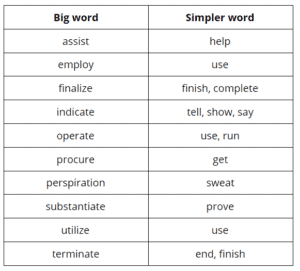
Avoid Sexist Language
Sexist language has the potential to offend – and it is near impossible to sell to people when they are offended. Instead, opt for gender-neutral terms or avoid such terms altogether. Here are a few ideas to illustrate:
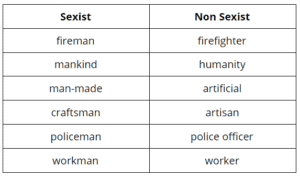
Use Your Brand Voice
One key to building a big Amazon business is to build a brand. Beyond adding a brand story to your listings, you can also write your product description using your brand voice. This gives your customers a consistent experience across all of your products and all platforms. This investment in branding can help build loyalty and increases the chances of turning your customers into repeat customers.
A Note on EBC
If you are brand registered and are using Enhanced Brand Content for your products, you will notice that EBC suppresses your product description, i.e. it is not visible on the frontend to customers. There are still hypothetical indexing benefits for adding one to the backend. Also, some data show that Google’s web crawler can index keywords in your product description which may lend to you ranking in their search results. The takeaway point? Add a description whether or not you’re using EBC.
Conclusion
If you’ve made it this far, you now have a fully optimized product description that will get you ranking higher in the search results, and convert more impressions into sales. To learn more ways you can optimize and grow your Amazon business, check out our online training where you can get your first course for free.